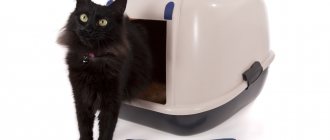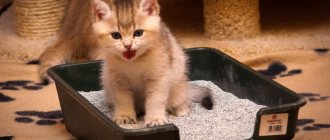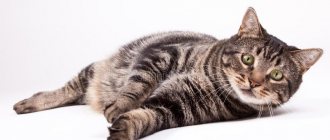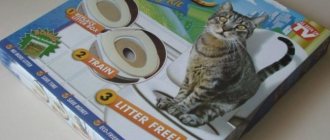Now that the long-awaited kitten has already bought all the dowry, all that remains is to deal with the most important thing - this is the cat litter. Today there are a huge variety of them in pet stores and you should not get confused when choosing a container. In our article we will look at the most economical and simple option - a tray with a grid.
Terms of use
In order for your pet to use such a tray, you need to prepare it. Since it consists of two main parts, everything is done very simply.
- Place filler at the bottom of a dry and clean plastic container.
- A mesh or lattice is placed on the top of the cat litter box. It is advisable to leave space between the tray and the grid so that cat urine gets inside, onto the litter. If the pet poops, the feces remain on the grill, which is then removed and thoroughly washed under the tap and dried.
- It is necessary to periodically wash the cat litter so that nothing stagnates, and then put in new litter.
Fighting the smell
It would seem that the filler is not visible, it is under the grate. And the cat does not come into contact with it. But there is still a smell in the house. So what should I do? How to deal with it?
The advice is simple: use an odor-absorbing product. These are sold at any pet store. Most often sold in powder form. This powder is poured onto the bottom of the cat litter box and “masked” with filler on top.
There is a more budget option. This is regular soda. It is poured onto the bottom of the tray as an odor absorber. The only negative is that the soda lasts for several days. And the absorber - for at least a week.
Varieties
Clumping: what are the features?
Bentonite clay and minerals are used to make these cat litter products. This hygiene product is widely known among cat owners and is often used. With its help, it is easy to absorb excess moisture, which turns into a lump. Using a spatula, the owner can easily remove used lumps of cat urine or feces from the toilet. It is recommended to buy clumping litter for a cat litter box if there is only one animal in the house, since if there are a large number of pets, the owner will have to remove the clumps throughout the day.
How is wood different?
Compressed sawdust granules retain odor well and are hypoallergenic, so they are suitable for both adults and small animals.
It is most profitable to fill a cat's litter box with this type of litter, since it is inexpensive and only a small amount of it needs to be placed on the bottom of the litter box. The product is compressed granules of sawdust, which become soaked upon contact with urine. A special feature of this litter intended for cat litter is its ability to retain odor well. Suitable not only for kittens, but the hygiene product is also used for adult cats. Since wood is a natural component, this filler almost never causes an allergic reaction in a cat.
Silica gel
Although this product is one of the most expensive, it does not require filling the cat's entire litter box. The filler consists of synthetic crystals of a transparent shade that absorb moisture well. The advantage of this product is the possibility of infrequent cleaning. If you fill the tray with a large layer of silica gel, then you will need to dispose of your cat’s litter box no more often than once every 2-3 weeks. The disadvantages of the litter are the sharp edges of the crystals and the loud rustling sound when the cat visits the litter box.
Features of mineral
The Fresh Step filler is a mineral filler, and when moisture gets in, it forms a lump, which makes it easy to clean the tray.
The composition includes clayey bentonite and palygorskite rocks. Popular brands of similar fillers:
- "Fresh step";
- "Murka";
- "Leopard";
- "Katsan";
- Jimpet Biocats;
- Vitacraft Compact Ultra.
After urination, a lump forms in the tray, which can be easily removed with a spatula. The main advantage of the hygiene product is that it is easy to clean, and it does not stick to the animal’s paws and does not spread around the house. It is possible to purchase filler with granules of different sizes. Experts do not recommend buying it for kittens who can swallow it. The disadvantage of mineral hygiene products is that they cannot be disposed of in the sewer.
Where is the best place to put a cat litter box?
Cats are very particular about their litter box, so choosing the right location for it is very important. And you, most likely, will not dare to install a tray on the carpet in the living room or kitchen. Remember the “one plus one” rule - you should have one “main” tray and one additional one. Accordingly, if you have two cats, there should be four trays, etc. Why is that?
These are such interesting animals - cats. They will never share their litter box with other animals. Many of our furry pets go even further in their requests - they prefer to urinate in one tray and defecate in another. Moreover, this requirement may appear suddenly! Therefore, always keep a spare tray ready.
So, let's try to find the right place for the tray
To do this, we must know something important from the nature of these beauties!. Place
Cats like to relieve themselves in solitude, out of sight. Moreover, they do this not at all out of modesty, but out of elementary fear: what if they are caught in such a vulnerable position by an insidious enemy! Based on this, we recommend, if you have one, to find a place in the guest bathroom. Problems with space in your apartment? Then find a quiet, non-traffic place if possible. If you don’t have any, buy a protective screen and place the tray in the corner of the living room or bedroom. You can successfully install the tray in both the bathroom and the toilet. Don't be afraid, the noise of the washing machine will not scare your pet
Place.
Cats like to relieve themselves in solitude, out of sight. Moreover, they do this not at all out of modesty, but out of elementary fear: what if they are caught in such a vulnerable position by an insidious enemy! Based on this, we recommend, if you have one, to find a place in the guest bathroom. Problems with space in your apartment? Then find a quiet, non-traffic place if possible. If you don’t have any, buy a protective screen and place the tray in the corner of the living room or bedroom. You can successfully install the tray in both the bathroom and the toilet. Don't be afraid, the noise of the washing machine will not scare your pet.
Away from food please!
Follow the rules of hygiene! We understand how much you love your cat and even kiss her from time to time, but still the tray and products are in no way compatible. Also, do not place the litter box in the same place where the cat eats, for the same reasons. Do not forget!
The tray is not a place for games!
This advice will be useful for those who have several cats. The fact is that cats love to play interactive games among themselves, hide in ambushes, and the tray often serves as a favorite place for such an ambush - cats love to literally fly up from there. In this case, move the litter box to an area where your pets do not play.
Avoid places that are too hidden and hard to reach.
When we say that cats love privacy in these matters, do not take everything literally and do not go too far: do not place trays in exotic places - in the basement, attic, etc., especially in places where you can only get by climbing a ladder . These exercises are especially difficult for kittens. And in this case, an adult cat will probably choose a more interesting place, and of course, outside your tray! A small exception should be made if you have a house with several floors: then we suggest setting up trays on each floor for the convenience of the animal.
Don't forget to keep the doors open!
You risk wasting all your time if, for example, you choose a place in the bathroom and then, out of habit, close the door there tightly. Remember: trays should always be freely accessible for pets!
Contact the services of furniture manufacturing companies!
If none of the proposed options suits you, then we advise you to look on the Internet for offers from some furniture companies that offer very nice multifunctional furniture sets with a cleverly camouflaged tray! For our taste, bamboo furniture is the ideal choice. It’s not a sin to place one like this in the living room!
Source
How to train a pet?
Preparing the toilet is only half the battle, since the other half comes from teaching your cat to go there to do its “business”. This works best when you have a small kitten.
- So, first of all, select a secluded place for the tray where the animal will feel comfortable.
- After this, you can put the cat in the tray several times a day. At the same time, make digging movements with its paws. Whenever you have the opportunity, watch the kitten and if you notice that the baby is acting restless, you can put it in the tray. If the kitten did his business there, be sure to reward him. Well, if the little cat did go the “wrong way,” you need to show the puddle to the baby and say something like: “Ugh” or “No way.” Gradually he will understand that he needs to go to the toilet in a certain place.
- If you have an adult cat, toilet training will be a little more difficult. Usually an animal that already has established habits has difficulty unlearning them. But even so, the situation is not hopeless. A cat is trained in much the same way, however, there are times when a pet, for some reason, purposefully relieves itself in another place. You can try to move the cat litter to where the cat does her business, and, quite possibly, the problem will be solved.
How to use a cat litter box correctly
Cats choose intimate places for the toilet, but who likes the smell and “heap” in an unexpected and hard-to-reach place. In order for the cat to get used to the designated “location” for the toilet and begin to use the tray for its intended purpose, you will have to teach your pet:
- place the toilet where the cat regularly goes;
- Move the tray a short distance day by day until you reach the desired location.
It is better if the cat litter box is secluded from prying eyes (for example, in the corner behind the washing machine) and is not located in the walkway.
The new tray is washed with laundry soap, rinsed several times in warm water, and allowed to dry. The same goes for the grate. Pour filler and a little freshener (optional) into the bottom. A mesh is placed on top.
Recommendations on how to use a cat litter box with a grid:
- Remove “lumps” in a timely manner by adding granules.
- If wood filler is used, the product is changed completely.
- Clean the grill regularly.
- Mandatory disinfection with detergent once every two weeks.
Types of cat toilets
The self-cleaning toilet is a tray with high sides that looks like a cozy house from the outside. Its internal dimensions are large enough for a cat of any breed to relieve itself comfortably: from a dwarf Munchikin to a 6-8 kg Maine Coon. After the pet has done its business, the owner just has to press a button to flush away the waste, and if there is a programming function, the flushing procedure will be performed automatically after a specified time.
Depending on the design and functionality, self-cleaning toilets come in several types:
Sensory. They work according to the “smart home” principle. The water is drained automatically, after the time set on the timer after the “cat has gone” signal from the touch sensor.
Sensory cat litter does not require litter, but it can be used if your cat absolutely refuses to relieve itself without first “digging a hole.”
With a reservoir for collecting excrement. The contents of the tray are emptied using a special device into a reservoir located at the bottom of the toilet, equipped with a bag for excrement.
Cat toilets with a collection system do not require a sewer system, but the collection bag must be replaced approximately once a week to prevent the occurrence of an unpleasant odor. A cat is a very clean animal, and may not want to go into a foul-smelling toilet, preferring another place to relieve itself, for example, your slippers or your favorite carpet.
With separate removal of excrement. The toilet tray is filled with special granules. Urine flows into the drain, and feces are removed there with a rotating scraper.
Removing cat urine from shoes
As soon as traces of a pet's crime are noticed, it is necessary to place the shoes under cold water, treat the shoes with potassium permanganate and wash them (either in a washing machine or by hand). Then, of course, it is advisable to dry it outside, but if this is not possible, a loggia will do.
You can wash soiled shoes with laundry soap with a high glycerin content, which very easily breaks down cat urine crystals.
If a cat shits in shoes that cannot be washed (boots, shoes), then the first thing you need to do is get rid of the insoles, where most of the liquid has been absorbed. Wipe the remaining internal parts with a vinegar solution or potassium permanganate and leave to dry in the fresh air (street, balcony).
You can also use an alcohol solution of iodine to clean shoes, but this product can only be used on dark shoes; marks may remain on light shoes. It is very simple to prepare such a solution: add 10 drops of iodine to 1 liter of water.
https://youtube.com/watch?v=Nyh6nMfzHQw
https://youtube.com/watch?v=Nyh6nMfzHQw
Advantages and disadvantages
Let's start with the pleasant things.
- It becomes clear that the obvious advantage is maintaining cleanliness. The cat relieves itself directly on the grate and does not touch the inside of the tray with the grate.
- Of course, the cat will not get the filler with its teeth and will not be able to taste it.
- It is worth noting that the advantage of this design is that the cat easily gets used to it and no longer does his “business” in another place.
- Manufacturers made sure that your apartment remains not only clean, but also aesthetically attractive, so they produced trays of various colors. You can choose the one that will be most in harmony with the overall decor in the room and will not be conspicuous by its inappropriate appearance and color.
One of the disadvantages is, perhaps, the fact that you will have to wash the grill every time after. Feces left on the grate for a long time can cause an unpleasant odor and, of course, your pet is unlikely to want to go to that toilet again. Meanwhile, even this drawback is covered by the obvious “spoon of honey”: the grille is very easy to clean. It is enough to throw away the feces after the animal poops, and then place the grate under running water. This way it cleans perfectly and there are no problems with cleaning the cat litter.
A cat litter box with a mesh has similar properties. In this case, we can safely say that it is available to any owner, since it is inexpensive. In addition, the kitten will easily get used to it. The mesh will be safe for the baby, providing him with comfort.
Features of a tray with a grid
To make the task easier for owners, a special toilet was invented for cats and cats, in which the pet feels free. But why is it so unusual, this tray for a pet?
Most owners choose closed toilets, where pets feel private. On the one hand, this is suitable for shy cats who hide from prying eyes. On the other hand, the litter inside does not spill out and the room where the cat litter is located remains clean. But there is also a drawback: not all cats like to sit in a closed toilet. And that’s why some kitties categorically refuse to visit such a “outhouse”.
What is typical for a tray with a grid?
- First of all, it is a lightweight and convenient plastic design that fits in any part of the apartment and can be carried without any problems if necessary.
- A tray with a grid differs in that the filler is located at the very bottom, in an area inaccessible to cat paws. And thus allows you to maintain cleanliness while having an animal in the house. It is logical that if you cannot reach it, the cat will not scatter it, because there is nothing to scatter.
- A convenient grille, which is installed on top, allows the pet to do its cat “business” without hindrance. After this, he will be able to safely leave the toilet until the next time.
How to wash, how to clean
Hygienic procedures are mandatory when using filler and without it. In the second case, you will have to clean the litter box after each time your pet goes to the toilet.
If the attribute is not taken care of, then one of the consequences is an unpleasant odor that will quickly spread throughout the entire apartment.
But the tailed pet will begin to regularly look for new places to relieve its natural needs, since the smell of excrement scares them away.
To clean your cat's litter box, you will need disinfectant (eco-friendly) detergents, a soft brush and paper towels.
Procedure. Everything will take no more than five minutes.
- The used filler is sent in a plastic bag.
- Having unfastened the removable mesh, the base is washed under warm water.
- Apply or spray detergent onto the tray and leave for a few minutes. Then the base is cleaned with a brush.
- The removable grate is cleaned in warm water.
Tray cleaner
Choosing a detergent
The most important criterion is the absence of strong odors. Be careful when using toilet bowl cleaners. Many of them have a pungent “aroma” that can scare away a cat.
As a result, the pet will have no choice but to go looking for a more comfortable place to go to the toilet.
Acid-containing products effectively fight urinary stones, which settle on the surface of the tray over time. An analogue of these is ordinary vinegar, but it only eliminates the smell and is not suitable for regular cleaning.
Eco-friendly disinfectants are the best option. They smell nothing and contain virtually no chemicals.
What folk remedies will help wash
To clean your cat's litter box, you don't have to buy expensive store-bought chemicals. The funds available in every home will come to the rescue. The main thing is to know the rules for their use and cleaning methods.
Table vinegar
To clean with table vinegar, you need to heat the substance to forty °C and fill the tray so that all the plaque is in the liquid. In this state, the container should stand for a certain time. If the contamination is shallow, then one hour will be enough. In case of heavy contamination, you must wait at least three hours. As time passes, you need to drain the vinegar and clean the pot with a brush and abrasives. Clean until the surface of the tray becomes smooth. Then rinse it with warm water and wipe dry.
Baking soda
It is used for mechanical stone removal and disinfection. You need to start by washing the tray. Next, dry soda must be poured onto the rough surface and rubbed into the urinary stone with a brush until it is removed. After the procedure, the cat litter box is rinsed again with warm water and dried outside.
Laundry soap
Soap must be dissolved in hot water. A soap solution is poured into a large container and parts of the tray containing urinary stone are placed in it. Next, the tray soaks for 24 hours. After this, the stone is removed with a stiff brush, and the pot is rinsed with water and vinegar.
Mustard powder
Mustard powder is applied to the wet surface of the tray and rubbed with a stiff brush into the surface damaged by the urinary stone. After cleaning, rinse the container with water. This cleaning will not only get rid of the stone, but will also help get rid of animal marks on different surfaces.
Cat litter box: what to fill it with?
The fact that there are special cat litters was discovered in Russia only recently – a quarter of a century ago. Until the 1990s, our country didn’t even have trays for cats; plastic trays (aka ditches) for photo printing were used for this purpose. Who else remembers these?
The most advanced urban cat breeders made with their own hands a “miracle of technology” - a dry tray made of two ditches. Holes were melted in the bath using a hot nail. Then it was inserted into another bath, and a “sandwich” was obtained, in which urine was drained through holes in the upper bath into the lower one.
Less advanced cat owners did it easier. The intelligentsia, who used toilet paper in everyday life, made bath fillers from finely chopped newspapers. And simpler people, who needed newspapers themselves, stole sand from children's sandboxes.
With the advent of the market economy, we now have special cat litter boxes and even special litter for them. Ironically, in the West at that time there was a boom in silicate fillers. At that time, silicate fillers were cheaper than natural ones and promised all sorts of benefits, for example, absence of odor and effective absorption of liquid. And natural fillers with the same properties also existed, but were much more expensive.
Over the course of a quarter century, the situation has changed dramatically. Today, natural fillers for trays have become cheaper than silicate ones. And this is their big plus!
What are the disadvantages of silicate fillers?
- Most of them contain sodium bentonite. This is a chemical agent that, when interacting with water, creates a sticking effect. By absorbing moisture, bentonite swells - 15 times its original volume - and forms a dense, water-insoluble mass. Unfortunately, not all of this mass remains in the tray. Lumps of it stick to the cat's paws. And the cat gnaws them out of his paws and swallows them. Sodium bentonite itself is not dangerous to the body; it is even used in the food industry - as an absorbent for clarifying wine or purifying moonshine. However, no one would think of swallowing already used bentonite.
- Silicate fillers contain silica. When you pour the filler into the tray, you can clearly see this silica in the form of a rising column of white dust. The same dust flies in all directions when the cat digs in the tray. But silica is not just dust. When inhaled, it acts as a carcinogen and increases the risk of cancer.
- Silicate fillers often contain artificial flavors. Their purpose is to give the cat's litter box a pleasant floral scent. But even a person, pouring the filler into the tray, sometimes holds his breath so as not to feel this stuffy smell. What can we say about a cat, whose sense of smell is much more subtle! Ideally, the cat's litter box should not smell of flowers or urine. It shouldn't smell like anything at all!
- From an environmental point of view, silicate filler is a disaster. According to environmentalists, about three billion tons of dust are blown away by winds from household waste dumps every year. Used litter that you throw in a landfill does not decompose. Never ever. This means that the mummified excrement of our cats will remain on Earth even when there is no trace of humanity left.
Photo: Kate Tomlinson/CC
Compared to silicate fillers, natural wood fillers have no disadvantages. And they already know how to do what only silicate ones could do before: retain moisture and lock in odor.
Does it make sense to spend 700 rubles on a five-kilogram pack of Katsana if the same amount of simple wood filler can be bought at Auchan for 50 rubles? And some “advanced” wood fillers even allow you to flush yourself down the toilet.
Source
Which filler is best to use?
If granules are not used, to avoid urine odor, you will have to wash the entire tray with the grid after each cat “mark”. Using filler under the mesh will relieve the pet from stress and the owner from unnecessary hassle.
The filler used is:
- wood pellets;
- silica gel;
- balls of water-absorbing zeolites and clay;
- pieces of toilet paper and newspaper;
- coarse river sand.
Granules from pressed wood waste are removed when they become wet, without adding new ones. How much filler is required depends on the material. Wood shavings and crushed pine needles absorb moisture differently than crushed corn cobs, but 1 kg of a hygienic mixture of wood and corn absorbs an average of 4 liters of liquid.
Silica gel swells from moisture, but does not form strong large lumps. The entire tray filler is replaced. Disadvantage: silicate gel is toxic. If a kitten swallows a ball, it may get sick. In addition, when wet, the filler hisses, which not every pet will like.
When using aluminas, moisture causes lumps to form, which can only be removed with a spatula. The filler is added as the amount in the tray decreases. Disadvantage: mineral dust, which causes respiratory diseases.
Paper is more of a one-time “express” method for travel containers. In everyday life, it only absorbs water without eliminating the smell. On the contrary, it serves as a breeding ground for bacteria. The lead in printing ink reacts with urine, gradually corroding the coating and plastic walls of the cat litter box. It is not recommended to use such fillers.
Sand also absorbs moisture. If you mix it with an odorant, the smell can be avoided. You need to have time to remove wet lumps; dry lumps (remain a source of odor) are more difficult to remove.
Used litter is thrown into a trash bag. You can throw it down the toilet only when the package is marked with a non-crossed-out toilet mark. The cat tray itself must be washed along with the grill and it is ready for subsequent use.
Source
Helpful Tips for Cleaning Your Cat's Potty
- Daily cleaning can be done by simply dropping detergent into the tray and then running it under running water to create a foam.
- Before pouring the filler into the tray, add half a pack of baking soda to the bottom - this will prolong the freshness of the filler and hide the unpleasant odor.
- About once a year, the cat's litter box needs to be replaced with a new one. No matter how thoroughly the cleaning is done, plastic accumulates odors over time. At first, pour the already used filler into the new tray, or place the old mesh in a new tray.
- You need to choose a time to wash the litter box at a time when the animal usually does not go to the toilet. There is no need to delay the hygiene procedure for a long time if the cat does not have a second tray - the pet may simply not be able to wait until the end of the cleaning.
- Under no circumstances should you use products designed to eliminate animal odor for your cat's potty. A cat can smell an unpleasant or even frightening aroma, and will forever “unlearn” the place reserved for the toilet.
A clean litter box is a must for every cat.
Why do you need a grille?
This accessory has a practical meaning. The filler is poured strictly under the grate, as it absorbs urine. The excrement will remain on top: the owner only needs to remove the part to rinse it under running water.
Some owners try to avoid mesh, citing the cat's physiology as an excuse. In their opinion, the accessory interferes with burying animal waste products, which means it will certainly cause discomfort. In the future, such a solution creates a whole wave of problems: the pet scatters the litter, dirt quickly accumulates and cleaning turns into a daily chore.
Different types of cat litter
Tray selection
Regular removal of excrement from the cat litter box, timely change of litter and periodic general cleaning will ensure the absence of unwanted odor in the house. But what if the owner does not have the opportunity to clean the toilet with the required frequency? In this case, you should take a closer look at special trays that do not allow the smell to spread.
Closed
Such a toilet not only keeps all the aromas inside, but also minimizes the scattering of the filler when buried. It is also perfect for those pets who do not like to relieve themselves in front of everyone. Manufacturers offer a wide selection of models with or without a door, corner and straight toilets.
Dry toilet
This is a fairly large product, equipped with a carbon filter and a fan. It eliminates unpleasant odors well, but requires regular filter changes.
You can learn about the intricacies of choosing a cat litter box from the video:
With automatic cleaning
These types of trays are high-tech devices that are capable of sifting, collecting and removing contaminated filler, using sewerage and water supply. The price of such toilets is quite high, but the owners do not have to waste time on cleaning and endure unpleasant odors.
As practice shows, owners who keep their cat litter clean do not encounter such a problem as an unpleasant odor. We hope that our tips will help simplify the process of cleaning up after your pet.
Where to put it in the apartment
This issue should be resolved on the first day the cat is in the house. The pet must be accustomed to one place for excrement, so that later the owner does not find “surprises” throughout the apartment.
Ideal areas are those that have low traffic and those that have virtually no noise. These are the most comfortable conditions under which the pet will agree to relieve itself and feel safe. Otherwise, “there will be trouble.”
If the choice falls on the toilet, make sure that the ward always has access to it.
Residents will have to put up with an open door, or constantly come running when their pet calls. Advice! Do not change the location of the tray. Cats are very conservative creatures and cannot tolerate any changes in their lives without stress. More temperamental individuals will declare “war” and continue to go where they went before.
Using a tray without filler: pros, cons, care rules
This design allows you to pour filler into the tray or do without it. When deciding not to use granules to fill the tray, you need to weigh the pros and cons. The advantages of this approach to arranging a cat litter box:
- Saving money on the purchase of filler.
- There is no need to clean up pellets scattered on the floor by your pet when trying to bury feces and urine. Another common problem does not arise - filler particles do not stick to the animal’s paws and fur and are not spread throughout the home.
- No risk of a curious little pet eating the pellets. Their entry into the kitten’s body is fraught with many serious and sometimes dangerous consequences: blockage of the intestines, damage to its walls by a foreign body, diseases of the digestive system.
- Keeping the home and cat clean. Some litters generate a lot of dust, contaminating the living space, paws and fur of the animal.
- There is no risk of the inhabitants of the home developing allergies and getting granules into the respiratory tract or being swallowed by a small child who gets to the cat's litter box.
Some cat owners refuse litter because their tailed pets for some reason do not want to interact with it. At best, this manifests itself in the fact that they do not bury feces; at worst, they ignore the tray, preferring to empty their bowels and bladder in the wrong places.
Disadvantages of using a tray without filler:
- The inability for an animal to realize its natural instinct. Some cats, deprived of the opportunity to bury feces and urine, begin to shit in places not intended for this.
- High risk of the smell of urine and feces spreading throughout the home. One of the main tasks of the filler is to absorb liquid excrement and urine, which significantly reduces the severity of the unpleasant odor.
- The need to clean the litter box immediately after your pet visits it, which is not always possible, especially for working people.
- Contamination of the animal's paws with urine and feces and spreading of their particles throughout the house.
Caring for this device is simple, but requires more time and effort than cleaning a litter tray. It is necessary to wash your pet's toilet with a grate after each use, and it does not matter whether the cat went into it in a small way or in a big way. Daily cleaning involves rinsing the structure with warm water, general cleaning involves soaking and using detergent and a special composition to eliminate the smell of cat urine.
Precautionary measures
Of course, precautions must be taken when selecting and using a tray.
- Be sure to use filler. It will definitely make life easier for both you and your cat. Change it more often, change types. You will definitely find something you like.
- Do not use or display substances that a kitten could easily eat. Kittens are very curious and if substances get into the respiratory and digestive tracts, problems cannot be avoided.
- Keep it clean. Cats are clean and also do not like to go to dirty places.
- Never add fragrances to attract the animal or to block unpleasant odors.
- Replace cheap plastic pots once a year. More expensive trays can be replaced every three years.
By the way, in order to remove the pot quickly and without hassle, you can use one piece of advice. Place a garbage bag on the tray of the pot and pour the filler into it. This option fights unpleasant odors and does not deposit urinary stones.










